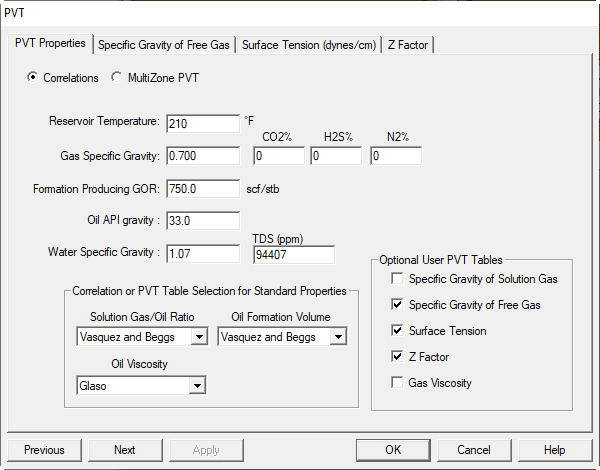|
<< Click to Display Table of Contents >> PVT Properties |
  
|
|
<< Click to Display Table of Contents >> PVT Properties |
  
|
PVT Properties

The following items may be edited on the PVT Properties Panel:
Reservoir Temperature (F): The bottomhole temperature at the reservoir depth. It is obtained from direct measurement or using the local geothermal gradient and the prevailing surface temperature: T = Ts + TG * TVD where:
T - the reservoir temperature (F)
Ts - the surface temperature (F).
TG - Geothermal gradient (F/ft).
TVD - true vertical depth at mid perforation (ft)
Gas Specific Gravity: The ratio of the molecular weight of the produced gas to the molecular weight of air. It is obtained from PVT analysis. The specific gravity of pure (100% methane is 0.565 while 0.7 is typical for associated gas.
Oil Gravity: The oil density defined by: API Gravity = (141.5/Specific gravity)-131.5 Where the specific gravity of the oil is the ratio of the oil density to the density of fresh water at standard conditions (i.e. 62.4 lb/cubic ft.)
Water Gravity: The ratio of the densities of the produced water to that of fresh water at standard conditions.
Gas Oil Ratio (scf/stb): For an oil well, this is the ratio of the produced gas in scf to the produced oil in stb. For a gas condensate well, this is the ratio of the produced condensate in stb per mmscf of produced gas, typically referred to as the liquid yield. A liquid yield of 1.0 is equivalent to a GOR of 1,000,000.
Separator Pressure (psia): The pressure at which the physical properties of the produced fluid were measured.
Separator Temperature (F): The temperature at which the physical properties of the produced fluids were measured.
Water Cut: This represents the produced water as a decimal fraction of the total liquid stream. Water Cut = water rate / (oil rate + water rate)
PVT Input Options: PVT data is handled separately for the IPR and Hydraulics calculations. For IPR, the choices are correlations and input values.
Solution Gas/Oil Ratio:
Laster's Correlation: Considered to be more accurate than Standing's correlation for higher gravity crudes (API > 15). (Trans. AIME, 1958, pg. 379)
Standing's Correlation: Based on 22 different California crudes. It is considered to have good accuracy for crude gravities less than 15 API. (API Drilling and Production Practices, 1947, pg. 275)
Vasquez and Beggs Correlation: Developed using a larger data base than Lasater's or Standing's work. This was done in order to make it a more generalized correlation. (J. Pet. Tech., June 1980, pg. 968). Best choice if you don't know any better.
Glaso Correlation: Developed for North Sea crudes and was generalized so that it could be applied to crudes from other regions. Results indicate it is a significant improvement over Standing's Correlation. (J. Pet. Tech., May 1980, pg. 785).
Oil Formation Volume Factor:
Standing's Correlation: Based on 22 different California crudes. It is considered to have good accuracy for crude gravities less than 15 API. (API Drilling and Production Practices, 1947, pg. 275).
Vasquez and Beggs Correlation: Developed using a larger data base than Lasater's or Standing's work. This was done in order to make it a more generalized correlation. (J. Pet. Tech., June 1980, pg. 968) Best choice if you don't know any better.
Glaso Correlation: Developed for North Sea crudes and was generalized so that it could be applied to crudes from other regions. Results indicate it is a significant improvement over Standing's Correlation. (J. Pet. Tech., May 1980, pg. 785).
Oil Viscosity:
The user may choose one of the following 3 options to generate the dead oil (or total liquid) viscosity. Dead oil viscosity is required as a baseline to calculate in-situ properties.
Beggs & Robinson Correlation: Good general purpose correlation.
Glaso Correlation: Select this option when using the Glaso solution GOR method.
Total Liquid Visc Table: This is a two dimensional viscosity table that can be used to override the correlations and provide a "net liquid viscosity" that will be independednt of water cut. This is also a good option when you want to hard-wire a specific liquid viscosity into the run to test its effects. Be sure to enter at least FOUR values so that the complete range of possible pressures and temperatures is covered by the grid entered. Recommended outside entries for the P&T ranges are:
Pressure: 0 to 22,500 psia
Temperature: 0 to reservoir temperature, DegF
Addition Viscosity notes: For and water mixtures, an inversion model is used to calculate the net viscosity of the system within the IPR relationships. Hydraulics mixing rules are followed according to each correlation's suggested averaging technique. The following plot describes IPR inversion model.
